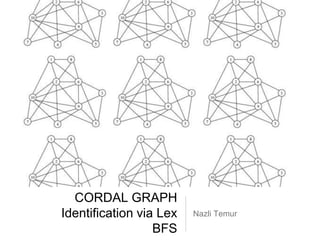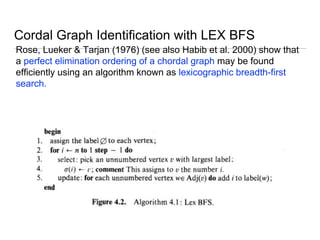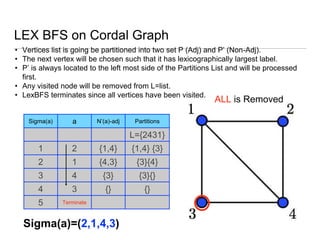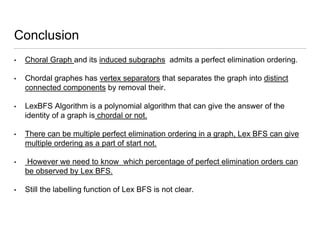LEXBFS on Chordal Graphs
- 1. CORDAL GRAPH Identification via Lex BFS Nazli Temur
- 2. Cordal Graphs [Triangulated Graphs] âĒ Definition. An undirected graph G is called Cordal-triangulated if every cycle of length strictly greater than 3 possesses a chord, that is, an edge joining two nonconsecutive vertices of the cycle. âĒ For a graph G on n vertices, the following conditions are equivalent: âĒ 1. G is chordal. âĒ 2.G has a perfect elimination ordering. âĒ 3. If H is any induced subgraph of G and S is a vertex separator of H of minimal size, Sâs vertices induce a complete subgraph of G.
- 3. Perfect Elimination Ordering A graph G on n vertices is said to have a perfect elimination ordering if and only if there is an ordering {v1, . . . vn} of Gâs vertices, such that each vi is simplicial in the subgraph induced by the vertices {v1, . . . vi}. As an example, the graph above has a perfect elimination ordering, witnessed by the ordering (2, 1, 3, 4) of its vertices.
- 4. // Simplicial âĒ Definition. In a graph G, a vertex v is called simplicial if and only if the subgraph (adjacency set) of G induced by the vertex set {v} ⊠N (v) is a complete graph. // a clique (not necessarily maximal)] âĒ For example, in the graph below, vertex 3 is simplicial, while vertex 4 is not: Vertex 3 Vertex4
- 5. Cordal Graphs [Triangulated Graphs] âĒ Definition. An undirected graph G is called Cordal-triangulated if every cycle of length strictly greater than 3 possesses a chord, that is, an edge joining two nonconsecutive vertices of the cycle. âĒ For a graph G on n vertices, the following conditions are equivalent: âĒ 1. G is chordal. âĒ 2.G has a perfect elimination ordering. âĒ 3. If H is any induced subgraph of G and S is a vertex separator of H of minimal size, Sâs vertices induce a complete subgraph of G.
- 6. // Vertex Seperator In graph theory, a vertex subset S subset V is a vertex separator for nonadjacent vertices a and b if the removal of S from the graph separates a and b into distinct connected components.
- 7. Note : A graph with no or one nodes is connected. Sconnected component 2 connected component 1 3rd Condition If H is any induced subgraph of G and S is a vertex separator of H of minimal size, Sâs vertices induce a complete subgraph of G. //induced subgraph is complete;
- 8. Cordal Graph Identification with LEX BFS Rose, Lueker & Tarjan (1976) (see also Habib et al. 2000) show that a perfect elimination ordering of a chordal graph may be found efficiently using an algorithm known as lexicographic breadth-first search.
- 9. LEX BFS on Cordal Graph Sigma(a) a Nâ(a)-adj Partitions L={2431} 1 2 3 4 5 âĒ Vertices list is going be partitioned into two set P (Adj) and Pâ (Non-Adj). âĒ The next vertex will be chosen such that it has lexicographically largest label. âĒ Pâ is always located to the left most side of the Partitions List and will be processed first. âĒ Any visited node will be removed from L=list. âĒ LexBFS terminates since all vertices have been visited.
- 10. Sigma(a) a Nâ(a)-adj Partitions L={2431} 1 2 {1,4} {1,4} {3} 2 3 4 5 LEX BFS on Cordal Graph 2 is Removed âĒ Vertices list is going be partitioned into two set P (Adj) and Pâ (Non-Adj). âĒ The next vertex will be chosen such that it has lexicographically largest label. âĒ Pâ is always located to the left most side of the Partitions List and will be processed first. âĒ Any visited node will be removed from L=list. âĒ LexBFS terminates since all vertices have been visited.
- 11. Sigma(a) a Nâ(a)-adj Partitions L={2431} 1 2 {1,4} {1,4} {3} 2 1 {4,3} {4} {3} 3 4 5 1&2 is Removed LEX BFS on Cordal Graph âĒ Vertices list is going be partitioned into two set P (Adj) and Pâ (Non-Adj). âĒ The next vertex will be chosen such that it has lexicographically largest label. âĒ Pâ is always located to the left most side of the Partitions List and will be processed first. âĒ Any visited node will be removed from L=list. âĒ LexBFS terminates since all vertices have been visited.
- 12. Sigma(a) a Nâ(a)-adj Partitions L={2431} 1 2 {1,4} {1,4} {3} 2 1 {4,3} {4} {3} 3 4 {3} {3}{} 4 5 LEX BFS on Cordal Graph 1&2&4 are Removed âĒ Vertices list is going be partitioned into two set P (Adj) and Pâ (Non-Adj). âĒ The next vertex will be chosen such that it has lexicographically largest label. âĒ Pâ is always located to the left most side of the Partitions List and will be processed first. âĒ Any visited node will be removed from L=list. âĒ LexBFS terminates since all vertices have been visited.
- 13. Sigma(a) a Nâ(a)-adj Partitions L={2431} 1 2 {1,4} {1,4} {3} 2 1 {4,3} {3}{4} 3 4 {3} {3}{} 4 3 {} {} 5 Terminate ALL is Removed LEX BFS on Cordal Graph Sigma(a)=(2,1,4,3) âĒ Vertices list is going be partitioned into two set P (Adj) and Pâ (Non-Adj). âĒ The next vertex will be chosen such that it has lexicographically largest label. âĒ Pâ is always located to the left most side of the Partitions List and will be processed first. âĒ Any visited node will be removed from L=list. âĒ LexBFS terminates since all vertices have been visited.
- 14. Conclusion âĒ Choral Graph and its induced subgraphs admits a perfect elimination ordering. âĒ Chordal graphes has vertex separators that separates the graph into distinct connected components by removal their. âĒ LexBFS Algorithm is a polynomial algorithm that can give the answer of the identity of a graph is chordal or not. âĒ There can be multiple perfect elimination ordering in a graph, Lex BFS can give multiple ordering as a part of start not. âĒ However we need to know which percentage of perfect elimination orders can be observed by Lex BFS. âĒ Still the labelling function of Lex BFS is not clear.
- 15. THANKS !


![Cordal Graphs [Triangulated Graphs]
âĒ Definition. An undirected graph G is called Cordal-triangulated
if every cycle of length strictly greater than 3 possesses a
chord, that is, an edge joining two nonconsecutive vertices of
the cycle.
âĒ For a graph G on n vertices, the following conditions
are equivalent:
âĒ 1. G is chordal.
âĒ 2.G has a perfect elimination ordering.
âĒ 3. If H is any induced subgraph of G and S is a
vertex separator of H of minimal size, Sâs vertices
induce a complete subgraph of G.](https://image.slidesharecdn.com/lexbfsoncordalgraphs-ppt-150513224017-lva1-app6892/85/LEXBFS-on-Chordal-Graphs-2-320.jpg)

![// Simplicial
âĒ Definition. In a graph G, a vertex v is called simplicial if and only if the subgraph
(adjacency set) of G induced by the vertex set {v} ⊠N (v) is a complete graph. // a clique
(not necessarily maximal)]
âĒ For example, in the graph below, vertex 3 is simplicial, while vertex 4 is not:
Vertex 3 Vertex4](https://image.slidesharecdn.com/lexbfsoncordalgraphs-ppt-150513224017-lva1-app6892/85/LEXBFS-on-Chordal-Graphs-4-320.jpg)
![Cordal Graphs [Triangulated Graphs]
âĒ Definition. An undirected graph G is called Cordal-triangulated
if every cycle of length strictly greater than 3 possesses a
chord, that is, an edge joining two nonconsecutive vertices of
the cycle.
âĒ For a graph G on n vertices, the following conditions
are equivalent:
âĒ 1. G is chordal.
âĒ 2.G has a perfect elimination ordering.
âĒ 3. If H is any induced subgraph of G and S is a
vertex separator of H of minimal size, Sâs vertices
induce a complete subgraph of G.](https://image.slidesharecdn.com/lexbfsoncordalgraphs-ppt-150513224017-lva1-app6892/85/LEXBFS-on-Chordal-Graphs-5-320.jpg)









